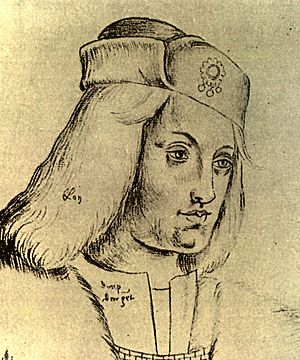Peace of Étaples facts for kids

|
|
| Type | Bilateral peace treaty |
|---|---|
| Signed | November 2, 1492 |
| Location | Étaples, France |
| Original signatories |
|
The Peace of Étaples was an important agreement. It was signed on November 3, 1492. The signing happened in a French town called Étaples. This peace treaty was between two powerful kings. They were Charles VIII of France and Henry VII of England. Charles VIII agreed to stop helping a person named Perkin Warbeck. Warbeck was a 'pretender' to the English throne. In return, Henry VII recognized Charles VIII as the ruler of Brittany.
This agreement stopped an English invasion of France. England had invaded because France was helping Perkin Warbeck. Warbeck claimed to be a prince from the House of York. He said he was the rightful heir to the English throne. An English army of 26,000 soldiers landed near Calais. They then surrounded the city of Boulogne.
Contents
What the Treaty Said
The Peace of Étaples was signed on November 2, 1492. King Charles VIII of France agreed to stop supporting Perkin Warbeck. He also agreed to pay England a large sum of money. This payment was called an indemnity. It was about £159,000. In return, King Henry VII of England accepted that France had rights over Brittany. The agreement was officially approved in December of that year.
Why the Treaty Was Important
King Henry VII presented this treaty as a big win for England. He showed it as proof that he had forced France to ask for peace. Getting rid of Warbeck from France was a major victory for Henry. It removed a key enemy who threatened his rule.
However, Henry's decision to give up on the Bretons was a change. It went against an earlier agreement from 1489. This was the Treaty of Redon. But in reality, Brittany had already accepted French rule. This happened when Anne of Brittany married Charles VIII in December 1491. This marriage meant Brittany was now under French control.
Later Renewals of the Treaty
The Peace of Étaples was important for many years. In July 1498, Louis XII, the new King of France, renewed the treaty. He did this before he invaded Italy in 1499. This showed the treaty was still valuable.
Later, in 1510, the advisors of Henry VIII also renewed the treaty. They wanted to continue the peace between England and France. This helped keep things calm between the two countries for a while.
See also
- List of treaties
Sources

